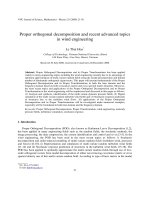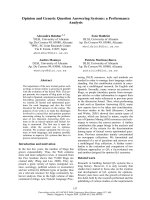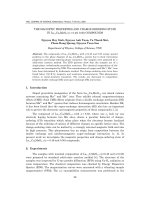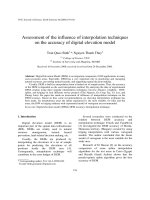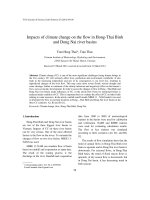Báo cáo " Assessment of OPRM1 and HRH2 gene variants in Vietnamese using RFLP-PCR " ppt
Bạn đang xem bản rút gọn của tài liệu. Xem và tải ngay bản đầy đủ của tài liệu tại đây (109.16 KB, 6 trang )
VNU Journal of Science, Natural Sciences and Technology 25 (2009) 228-233
228
Assessment of OPRM1 and HRH2 gene variants in
Vietnamese using RFLP-PCR
Dinh Doan Long*, Nguyen Thi Hong Van, Nguyen Anh Luong,
Tran Thi Thuy Anh
Faculty of Biology, College of Science, VNU, 334 Nguyen Trai, Hanoi, Vietnam
Received 17 December 2009
Abstract. The gene encoding the mu-opioid receptor (OPRM1) has been reported to associate with
a range of substance dependence and HRH2 is the gene coding histamine H2 receptor, the site of
action for various compounds, e.g. amitriptiline and mianserin, used in the treatment of psychiatric
disorders. Both OPRM1and HRH2 genes contain some single nucleotide polymorphisms (SNPs),
including +118A/G in OPRM1 and +398T/C in HRH2, which were reported to change in protein
sequences and result in affecting the therapeutic response. Some previous studies revealed linkage
between these rare alleles and propensity towards drug dependence. This paper reports the data of
an investigation on frequencies of several SNPs at OPRM1 and HRH2 loci in a Vietnamese
population by using RFLP-PCR technique. For OPRM1, the IVS2+691G allele appeared with a
frequency of 25%. The SNP +543G/A were found at the HRH2 locus with frequency of 5%. These
frequencies seemed to concur with those found in previous studíes in some other Asian
populations, such as Japanese, Indian or Chinese but notably the frequencies of these alleles found
in Vietnamese appeared to differ significantly from those found in European and African-
American populations as revealed by previous investigations.
Keywords: mu-opioid receptor, histamine H2 receptor, single nucleotide polymorphism (SNP),
PCR-RFLP.
1. Introduction
∗
Pharmacogenetic approaches provide a
method for identifying mechanisms underlying
interindividual response variation and, in
particular, identifying patients who have a
higher probability of benefiting from a
particular medication [1]. Because medications
appear to exert their therapeutic effects through
_______
∗
Corresponding author. Tel.: 84-4-38584748
E-mail:
distinct mechanisms, knowledge of specific
genetic predictors of response could make it
possible for treatment to be matched to patients
so as to optimize therapeutic response and
minimize adverse effects.
Compounds used to treat many diseases
work by activating a receptor or inhibiting the
action if it is natural ligand. Variation in
receptors amongst the population is known to
be caused by allelic variation and this variation
can alter the response of a disease to a drug
amongst patients.
D.D. Long et al. / VNU Journal of Science, Natural Sciences and Technology 25 (2009) 228-233
229
The mu-opioid receptor is implicated in the
reward, tolerance and withdrawal effects of
alcohol and other drugs of abuse. Thus, the
genetic loci that code for these opioid receptors,
OPRM1, OPRD1, and OPRK1, respectively,
are potential targets for pharmacogenetic
studies of naltrexone (NTX) treatment effects.
The mu-opioid receptor plays a central role in
mediating the effects of morphine and related
opioid agonists. Detection of genetic variation
affecting OPRM1 expression or mu-opioid
receptor function would be an important step
towards understanding the origins of inter-
individual variation in response to mu-opioid
receptor ligands and in diseases of substance
dependence. The OPRM1 gene encodes the mu-
opioid receptor, OPRM1 maps to chromosome
6q24–q25 [2].
Four nucleotide variants (+17C/T,
+118A/G, +440C/G (relative to the ATG) and
IVS2+691C/G) were observed [3]. One obvious
candidate variant for such an effect is the
A118G single nucleotide polymorphism (SNP)
in exon 1 of OPRM1. This polymorphism
encodes an Asn40Asp amino acid substitution
and is reported to be functionally important, but
while there are several reports showing that this
variant is functional, they are not easily placed
in a consistent framework regarding the nature
of the functional effects [4]. Additionally, the
C17T which encodes a variant receptor with a
Val at position 40 instead of Ala, have been
found with varied frequencies across
populations. These findings demonstrated that
the opioid system is involved in the reinforcing
properties of alcohol and that allelic variation at
OPRM1 is associated with differential response
to medications active at the mu-receptor.
Therefore, genetic variation at loci coding for
opiate system proteins, including OPRM1,
might be expected to affect risk for drug
dependence and alcoholism, and possibly other
addictive behaviors as well.
Histamine is natural constituent of many
organs and tissues including the gastrointestinal
tract, the immune system and the brain [5]. It is
a central neurotransmitter in the brain and is
formed in the posterior hypothalamus from
exogeneous histidine by histidine
decarboxylase (HDC). There are three known
histamine receptors: H1, H2 and H3, the latter
functioning as an autoreceptor. The H2 receptor
is a site of action of various compounds used in
the treatment of psychiatric disorder, e.g.
amitriptiline and mianserin. Health et al. (2002)
have reported the successful response of
patients with chronic, predominantly negative
type schizophrenia, to the highly specific H2
receptor antagonist famotidine [6]. HRH2 is
gene encoding the human histamine H2
receptor. The A649G SNP in this gene, leading
to amino acid substitution of an Asn at position
217 by Asp was found to be associated with
schizophrenia in British Caucasians [6].
In the present study, we applied PCR-RFLP
in investigating the frequency of such SNPs in
Vietnamese subjects as our preliminary
assessment [7]. For OPRM1, the 118G allele
appeared with a relatively high frequency of
38%. Neither the 17T nor 649G allele of HRH2
were found in the study, suggesting that these
variants, if present, is uncommon in the
Vietnamese population. In this publication, we
extended our assessment by analyzing the
frequencies of IVS2 +C691G locus in intron 2
of OPRM1 gene and G543A SNP in HRH2
gene in Vietnamese, using PCR-RFLP method.
These results suggest that natural variations that
might affect function and/or be associated with
psychiatric phenotypes related to therapeutic
response in medication.
D.D. Long et al. / VNU Journal of Science, Natural Sciences and Technology 25 (2009) 228-233
230
2. Materials and methods
2.1. Materials
The Vietnamese population sample is
composed of 100 Vietnamese individuals and
were collected randomly from patients in the
Hanoi Huu Nghi Hospital and National Institute
of Hematology and Blood Transfusion,
Vietnam. Venous blood samples were collected
in vials containing EDTA and stored in -20
o
C
for a week to a month.
2.1. Methods
DNA extraction. Genomic DNA was
extracted from blood samples by using standard
precipitation described by Sambrook et al.
(2001) [8] with some minor modifications. The
extracted DNA products were analyzed on a
0.8% agarose gel and measured at OD
280
and
OD
260
. OD
260
/OD
280
was calculated to identify
the extraction efficacy and intactness of the
genomic DNA.
PCR-RFLP genotyping. For OPRM1,
fragment 235bp was amplified by using the
primers designed incorporating mismatched
base (capitalized below) to produce artificial
restriction sites (bold) in order to analyze SNP
IVS2+691C/G: forward primer: 5’–gct ctg gtc
aag gct aaG aat–3’ (where a G was substituted
for an A at position -4 to create a HinfI site);
reverse primer: 5’–gat cat cag tcc ata gca cac
gg–3’). PCR cycling parameters consist of a
5min hold at 95
o
C, followed by 30 cycles of
95
o
C (1min), 61
o
C (1min) and 72
o
C (1min).
Reaction mixture consists of 0.4µM each
primer (Bioneer), 0.2mM dNTP, 1u Taq
polymerase/25µL of reaction and 4mM MgCl
2
.
Following amplification, the reaction mixture
was digested with HinfI restriction
endonuclease (Fermentas) which
correspondingly cuts the 691C allele resulting
in 20bp and 215bp fragments. Fragments were
resolved by 3% agarose gel electrophoresis.
For HRH2, the primers included: forward
5’-cca atg gca cag cct ctt–3’ and reversed 5’–
gca gca gaa gag ctg ttg–3’ was used to amplify
a 909 bp fragment. Optimized conditions for
this PCR reaction are 0.4µM of each primers,
0.4mM dNTP, 1u Taq polymerase/25µL
reaction and 3mM MgCl
2
. PCR cycling
parameters consist of a 5-min hold at 96
o
C,
followed by 30 cycles of 96
o
C (1min), 57
o
C
(1min) and 72
o
C (1min 20s). PCR products
were subsequently added to XmiI restriction
endonuclease (Fermentas) which yield
fragments of 536bp and 373bp upon XmiI
digestion of the variant PCR product containing
allele (rare) 543A. The common allele 543G
has no XmiI restriction site. Reaction products
were analyzed by electrophoresis on the 1.5%
agarose gel.
The χ
2
test was applied for verifying the
allele frequency distribution of the SNPs.
3. Results and discussion
DNA extraction. Genomic DNA was
extracted from blood samples anticoagulated
with either EDTA by using the methods
described by Sambrook et al (2001) [8].
Fig 1. Electrophoresis on 1% agarose gel of genomic
DNA extracted from blood samples. M: Marker λ
HindIII; E1 – E8: Genomic DNA products.
D.D. Long et al. / VNU Journal of Science, Natural Sciences and Technology 25 (2009) 228-233
231
In our study, the results showed that
genomic DNA was extracted successfully with
this method (Fig.1). Whole genomic DNA
appears as a sharp, bright band in agarose gel of
electrophoresis. Optical density assay showed
relatively purified products of OD
260/280
values
ranging from 1.6 to 2 and the concentration of
DNA were 30 - 400µg/mL. The DNA samples
subsequently were diluted to concentration of
50 µg/mL for further PCR experiments.
Polymerase chain reactions. The
optimization of primer annealing was
performed on purified DNA samples. The
annealing temperature was identified as 61
o
C
for the best result. For amplification of 235bp
fragment to analyze IVS2+691C/G SNP in
OPRM1 gene, PCRs were operated and we have
obtained specific DNA bands at the size of
235bp as expected according to its theoretical
calculation (Fig. 2).
Fig 2. Electrophoresis of PCR products OPRM1
gene on agarose 1.5%, 60V. DC: negative control;
lane 1-7: PCR products; M: DNA marker 1kb.
For genotyping of HRH2, the amplifying
also obtained the 909bp fragment (nucleotide
+8 to nucleotide +916), which appeared as one
sharp and specific band in the electrophoresis.
These results were illustrated in Figure 3.
Fig 3. Electrophoresis of PCR products HRH2 gene
on agarose 1.5%, 60V. DC: negative control; lane 1-
7: PCR products; M: DNA marker 1kb.
Genotyping and data analysis. The PCR
products from both of OPRM1 and HRH2 genes
were used for digestion reaction with HinfI and
XmiI respectively. Upon HinfI digestion, in 100
samples in this study, frequency of individuals
with homozygotic genotype IVS2+691C/C was
0.56, heterozygotic genotype +691C/G was
0.37 and +691G/G was 0.07. The figure 4
below is illustration of this result.
Fig 4. Digestion of PCR product IVS2-OPRM1 gene
with HinfI for analysis of IVS2 +691C/G SNP. M:
marker 1kb; Lane 1, 6 and 7: homozygote CC; lane
3 and 4: GG; lane 2 and 5: heterozygote C/G.
From that, we calculated allele frequencies
of +691C and +691G as 0.75 and 0.25,
D.D. Long et al. / VNU Journal of Science, Natural Sciences and Technology 25 (2009) 228-233
232
respectively. These results confirmed by χ
2
test
(χ
2
(2)
= 0.098 lower than the χ
2
value of
statistical significant at p = 0.05 which is 5.99),
showing that the frequencies of these alleles
reached to balanced state and there were no
deviations from Hardy-Weinberg expectations
in the population. The comparisons of +691G
allele frequencies between Vietnamese and
other population indicated that, the frequency of
this rare allele Vietnamese is of average to other
Asian populations and relatively low compared
to other populations world-wide.
Genotyping of HRH2 gene for analysis of
allele frequencies of +543G/A SNP was
performed by digestion reaction of XmiI.
Because of the common allele +543G without
restriction site and the rare (mutated) allele
+543A with one restriction site of this enzyme
and result in two bands 536 and 373 bp, we can
identify the genotype of individuals in study.
Fig 5. Digestion of PCR product HRH2 gene with
XmiI for analysis of +543G/A SNP. M: DNA marker
1kb; Lane 1and 3: heterozygote G/A; lane 2, 4 – 8:
homozygote GG.
Amongst of 100 samples, 90% are GG
homozygous, 10% are GA heterozygous and
there is no AA homozygote in our study. The
frequencies of these alleles are 0.95 (G) and
0.05 (A). These frequencies were tested usingχ
2
test (χ
2
(2)
= 0.277, lower than the χ
2
value of
statistical significant at p = 0.05 which is 5.99).
This result also indicated that there were no
deviations from Hardy-Weinberg expectations
for distribution of alleles +543G/A in this
Vietnamese population.
4. Conclusion
The assessment of the frequencies of single
nucleotide polymorphisms in OPRM1 gene
(IVS2+691C/G) and gene coding histamine H2
receptor HRH2 (+543G/A) with 100
Vietnamese individuals showed that, both of
these SNPS were found in our subjects with
identified frequencies. The +691G variant in the
OPRM1 gene was at the frequency of 0.25 and
+543A variant of HRH2 was 0.05. In the
analyzed loci, the frequencies of genotypes are
followed Hardy – Weinberg expectation. This
means that, the genetic compositions of these
alleles are quite balanced, at least in our 100
individuals of this study.
The comparisons of the frequencies of
common SNPs in OPRM1 and HRH2 genes in
Vietnamese appeared to be similar to those
previously found in Asians, e.g. Japanese,
Indian, Chinese etc. but significantly differed
from those of Europeans and African-
Americans, like our judgment in previous
publication [7].
Acknowledgements
The authors would like to express sincere
thanks to the Vietnam National University-Hanoi
for funding the project (Research Grant No.
QG.08.09). We are also grateful to Assoc. Prof.
Trinh Dinh Dat from Faculty of Biology, Hanoi
University of Science, for his continuing expertise
support and proof-reading the manuscript.
D.D. Long et al. / VNU Journal of Science, Natural Sciences and Technology 25 (2009) 228-233
233
References
[1] G. Joel, G. Ralitza, et al., Opioid Receptor
Gene (OPRM1, OPRK1, and OPRD1)
Variants and Response to Naltrexone
Treatment for Alcohol Dependence,
Alcoholism: Clinical and experimental
research, Vol. 31, No. 4 (2007).
[2] J. Gelernter, H. Franzler, J. Cubells, Genetics
of two mu-opioid receptor gene (OPRM1)
exon I polymorphisms: population studies,
and allele frequencies in alcohol- and drug-
dependent subjects, Molecular Psychiatry 4
(1999) 476.
[3] A. W. Bergen et al., µ opioid receptor gene
variants: lack of association with alcohol
dependence, Molecular Psychiatry 2 (1997)
490.
[4] C. Bond, et al., SNP in the human mu-opioid
receptor gene alters β-endorphin binding and
activity. Proceedings of the National Academy
of Sciences USA 95 (1998) 9608.
[5] Paul Roy Heath et a.l, Allenle of Human
histamine H2 receptor and methods of
detection of H2 receptor variants. United
states Patent, Patent No. US 6,440,670 B1
(2002).
[6] P.R. Health, et al., Allele of human histamine
H2 receptor and methods of detection of H2
receptor variants, US Patent, US 6440670
(2002).
[7] Dinh Doan Long, Nghiem Phuong Le,
Nguyen Thi Hong Van, Hoang Thi Hoa,
Single nucleotide polymorphism in µ-opioid
and histamine H2 receptor GENES WITHIN
Vietnamese population, VNU Journal of
Science, Natural Sciences and Technology 24
(2008)
[8] Sambrook et al., Molecular cloning: A
laboratory manual. Vol. 1. Cold Spring Harbor
Laboratory Press (2001).
Đánh giá đa hình đơn nucleotit trong gen OPRM1 và HRH2 ở
người Việt Nam sử dụng RFLP-PCR
Đinh Đoàn Long, Nguyễn Thi Hồng Vân, Nguyễn Anh Lương, Trần Thị Thùy Anh
Khoa Sinh học, Trường Đại học Khoa học Tự nhiên, ĐHQGHN, 334 Nguyễn Trãi, Hà Nội, Việt Nam
Gen mã hóa thụ thể mu-opioid (OPRM1) được cho là có liên quan tới sự phụ thuộc thuốc và các
chất gây nghiện. HRH2 là gen mã hóa thụ thể histamine H
2
, vị trí hoạt động của nhiều hợp chất được
sử dụng trong điều trị các bệnh liên quan đến tâm thần (amitriptiline và mianserin). Cả hai gen này đều
chứa những vị trí đa hình đơn nucleotit - SNP (chẳng hạn, +118A/G ở gen OPRM1, +398T/C ở gen
HRH2…) dẫn đến những thay đổi về trình tự axit amin của protein và từ đó làm ảnh hưởng tới đáp
ứng thuốc trong điều trị. Nhiều nghiên cứu trước đây đã đưa ra mối liên kết giữa các alen hiếm này và
xu hướng phụ thuộc thuốc. Trong nghiên cứu này, chúng tôi khảo sát các SNP IVS2+691C/G và
+543G/A ở hai gen OPRM1 và HRH2 trong nhóm 100 cá thể người Việt Nam được thu thập ngẫu
nhiên từ Bệnh viện Hữu Nghị, Hà Nội và Viện Huyết học và Truyền máu Trung ương, Việt Nam,
bằng kỹ thuật RFLP-PCR. Kết quả cho thấy, với gen OPRM1, alen IVS2+691G xuất hiện với tần số
25%. Alen +543A ở HRH2 được tìm thấy với tần số 5%. Các tần số này khá gần với tần số các alen
tương ứng trong các quần thể người ở Châu Á, như Nhật Bản, Ấn Độ, Trung Quốc… nhưng khác biệt
so với tần số của các alen này ở người Châu Âu và người Mỹ gốc Phi.
